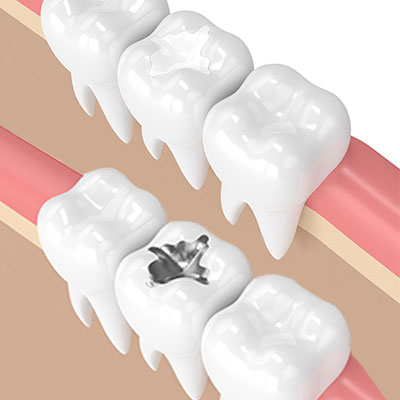Composite Fillings (or tooth-colored fillings)
Composite fillings made up of a ceramic and plastic compound. Resin looks like natural teeth, so these fillings blend in right away. There are also referred to as “white fillings” or simply, “tooth-colored fillings.”
Here are some benefits of resin composite fillings:
- Invisible: These fillings blend in since they are the same color as teeth.
- Easy bond: Resin composite will easily bind to the surface of your tooth.
- Preserves more of the tooth. The resin is flexible, which means less drilling is needed.
Metal Fillings vs Composite Fillings

Tooth-colored fillings Not only offer an aesthetic alternative to “silver” fillings and allow for a more conventional treatment method to preserve the tooth’s structure.
Tooth-colored fillings are made of a combination of plastic resins and silica fillers. These substances can mimic the qualities of natural tooth structure. They are also wear-resistance, translucent, and help strengthen teeth.
While looks alone are enough to see why someone would want a tooth-colored restoration, especially for their front teeth, it’s a good idea to understand some of the other advantages composite resins offer, even for back teeth.
Steps Involved in Filling a Tooth
1. Professional Dentists use an anesthetic to numb the area surrounding the targeted tooth.
2. Next, the dentist will use either a drill, air abrasion instrument, or laser to remove the decayed area. Dentists choose an instrument depending on their individual comfort level, level of training, and investment in a particular piece of equipment. They may also choose an instrument based on the location and extent of the decay.
3. Next, dentists will inspect and test the area to verify that all of the decay has been taken out. After the decay has been removed, the dentist will prepare the area for the filling by cleaning the cavity of any bacteria and debris. If the decay is close to the root, the dentist may put in a liner first, which as usually made of glass ionomer, composite resin, or other materials to shield the nerve.
4. Lastly, after the filling is in, dentists will polish it.

Additional steps required for tooth-colored fillings:
- After dentists remove decay and clean the area, the tooth-colored material is applied in layers. They will then use a special light that cures (or hardens) each layer that is applied.
- Once the multilayering process is complete, the dentist shapes the composite material into the desired result.
- Lastly, the dentist will trim off any excess material and polish the final restoration.
Composite Filling with our Livermore Dentists

At Foothill Dental Care in Livermore, our goal is to help you maintain your beautiful smile and maintain good oral health. If cavities are left untreated, they can worsen and the compromise the entire tooth. The infection can then spread to your gums, roots, and jawbone. We urge our patients to have regular visits to help us detect decay in the enamel before a filling is even required.
If you are interested in getting an appointment, call our office at (925) 961-5484 to schedule an appointment today.
Normal insurance that covers dental treatment has the policy which will cover regular checkups and cleanings 1 to 2 session a year. There is a chance that a patient would have to pay out-of-pocket depending on how much their insurance cover. If you have premium dental insurance plans, it is highly likely that your plan covers most or all of the expenses related to the cavity and composite fillings.
While early research has shown that the average tooth-colored filling can last up to five years, though there are many things both dentists & patients can do to prolong the life of a white filling to ten years or more.
There have been many scientific and clinical studies that have shown tooth-colored fillings are safe, dependable and long-lasting. They not only look great they can withstand moderate pressure from the constant stress of chewing.
